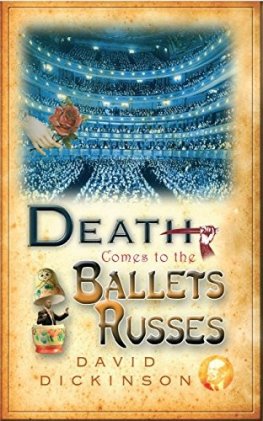David Dickinson - Death Comes to the Ballets Russes
Here you can read online David Dickinson - Death Comes to the Ballets Russes full text of the book (entire story) in english for free. Download pdf and epub, get meaning, cover and reviews about this ebook. year: 2015, publisher: Constable, genre: Detective and thriller. Description of the work, (preface) as well as reviews are available. Best literature library LitArk.com created for fans of good reading and offers a wide selection of genres:
Romance novel
Science fiction
Adventure
Detective
Science
History
Home and family
Prose
Art
Politics
Computer
Non-fiction
Religion
Business
Children
Humor
Choose a favorite category and find really read worthwhile books. Enjoy immersion in the world of imagination, feel the emotions of the characters or learn something new for yourself, make an fascinating discovery.
- Book:Death Comes to the Ballets Russes
- Author:
- Publisher:Constable
- Genre:
- Year:2015
- ISBN:9781472113795
- Rating:4 / 5
- Favourites:Add to favourites
- Your mark:
- 80
- 1
- 2
- 3
- 4
- 5
Death Comes to the Ballets Russes: summary, description and annotation
We offer to read an annotation, description, summary or preface (depends on what the author of the book "Death Comes to the Ballets Russes" wrote himself). If you haven't found the necessary information about the book — write in the comments, we will try to find it.
Death Comes to the Ballets Russes — read online for free the complete book (whole text) full work
Below is the text of the book, divided by pages. System saving the place of the last page read, allows you to conveniently read the book "Death Comes to the Ballets Russes" online for free, without having to search again every time where you left off. Put a bookmark, and you can go to the page where you finished reading at any time.
Font size:
Interval:
Bookmark:
David Dickinson
Death Comes to the Ballets Russes
1
Being on demi-pointe is like being on tiptoe. The ball of the foot is in contact with the floor, and is supporting the weight of the body. Sometimes this movement is referred to as three-quarter pointe. When a dancer is wearing pointe shoes, she can raise to en-pointe, where she is actually using the tip of her foot to support her weight on the floor.
New Year is the season of hope or despair. For the young, the first day of January brings another chance of true love, the prospect of a new job with new horizons. For the middle-aged, it is the time when people start to look back as well as forward, the time when the first faint lines start to appear on what had been perfect skin, the time funerals start to replace weddings and christenings as the rite of passage. For the old, they know that the aches and pains that have grown into permanent fixtures are never going to go away now; they know that time is not going to run backwards to make them fit and healthy again; they know that each New Year might be the last and, more surely than ever, that death comes at the end.
For the gilded aristocracy of Europe, New Year always begins with a ball. In the perfectly sprung ballrooms of the Habsburgs and the Romanovs, from the Hofburg in Vienna to the Winter Palace in St Petersburg, aristocrats dress up and dance. Like the Roman god Janus, who gave his name to the month of January, the dukes and duchesses, the princes and princesses, the counts and countesses face both ways at once. They look back, secure in the knowledge that their family has left its mark on history across the centuries. They look forward, secure in the knowledge that their family will leave its mark on the centuries to come.
Princess Marie Golitsyn thought she must have the largest collection of jewellery boxes in St Petersburg. All of them, large or small, were open on her dressing table, their contents spilling over the sides and rolling away across the floor. She had jewellery boxes made with different kinds of wood, walnut and rosewood and mahogany. There were silver ones, boxes inlaid with silver or platinum; even a box shaped rather like a heart in the Art Nouveau style. The Princess had gold and silver ornaments, she had rubies and sapphires and emeralds and pearls. She had bracelets and chatelaines and carcanets and a couple of diadems left to her by her favourite aunt. There was a diamond tiara made by Faberg, a present from her husband a few years before. The Princess discovered later that it was one of a pair. The other one had gone to her husbands mistress in Moscow.
Princess Marie was one of a vast throng of aristocrats in the Russian capital preparing for a ball at the Winter Palace. She had been at her dressing table for an hour and a half and thought she would be ready quite soon. The carriage was waiting outside in the snow. She could hear her husband pacing up and down the hallway. She knew that if she didnt finish her toilette soon he would be so drunk that it would be impossible for him to go to the palace at all. She decided on the triple ring of pearls and a dog-collar-style choker necklace. A series of diamonds encircled the top of her ornate dress from Worth in Paris. She added earrings and the Faberg tiara, bracelets for her wrist and a sapphire star, the most valuable piece she possessed, pinned to her waist. Her fingers shone with the pure gold of a couple of rings believed to have been created in Paris at the end of the seventeenth century for a mistress of the Sun King. Princess Marie Golitsyn rose from the table and swept down the stairs. She left her jewels strewn all across her dressing table and the boxes lying around on the floor. The servants could pick them up later. That was what servants were for.
Ten minutes later she was handing her cloak to one of the attendants outside the Winter Palace. Ahead she could see the white marble staircase that led up to the gigantic galleries, each one as tall as a cathedral. Baskets of orchids lined the walls, flanked by enormous mirrors where the ladies could inspect their adornments and make final adjustments to their dcolletage. Cossack Life Guards in scarlet tunics stood to attention every fifty yards. But for Princess Golitsyn and her cousin Tatiana, who lived next door, and for Princess Nathalie, her neighbour on the other side of the Fontanka Quay, the important people that evening were not their husbands or the soldiers or the lovers they would dance with under the glittering chandeliers. The important people were their sons.
The Russian capital St Petersburg had always been blessed with more than its fair share of dissolute and depraved young men, who spent money they did not have in the gambling clubs; young men who bought expensive presents on credit for the stars of the opera and the theatre; young men who spent lavishly on the pretty wives of their contemporaries they thought might be compliant. Most of these young men were bailed out by reluctant fathers and families. But as the New Year Ball of 1912 drew closer, two young men, Prince Alexis Kishkin and Prince Felix Peshkov, officers in the fashionable Preobrazhensky Guards, found that all the doors in front of them were shut. Their fathers and grandparents had closed ranks, refusing any further loans and insisting that the income the young men had inherited on coming of age be used to pay down their debts. The banks were under instruction not to lend the young men a single rouble. This was easier than it might have appeared, as Peshkovs father owned one bank and had considerable shareholdings in two others.
The young men relied on secret contributions from their mothers. We couldnt let Alexis starve. In the dying days of 1911, the impoverished young men had hatched a daring scheme to restore their fortunes. The season for great balls in St Petersburg was approaching. The young men had often seen their mothers preparing for these evenings. The most difficult choice was never what clothes to wear, but what jewels should adorn them. Few women in Europe loved their gems like the aristocratic women of St Petersburg. The young men knew that special boxes and caskets would be brought out. Various combinations would be tried. The final decision was usually left to the very last minute.
As the carriages and the sledges sped across the snow to the New Years Ball in the Winter Palace, the young men made their move. Characteristically they took one big gamble. They gambled that their mothers would not have put their jewels away. They would still be littered across the dressing tables and the dressing-room floors. They put on their most splendid uniforms and charged into three of the grandest houses on Fontanka Quay, the Belgravia of St Petersburg, home to Princess Marie Golitsyn and her cousin Tatiana and her friend Princess Nathalie. They brought six of their soldiers to act as sentries and lookouts. Theres been a robbery! they shouted as the butlers let them in. Tell everyone to stay where they are and not to move! The young men sped upstairs and gathered pearls and diamonds, emeralds and sapphires, gold and silver, into three different saddlebags. Then they disappeared into the night.
The following week they took a train to Moscow. They consulted a dealer. He said it would be impossible to sell the jewels in Russia, as the authorities probably had details of every single piece by now. He advised taking them to Antwerp or London and selling them there. Prince Felix Peshkov had a special friend in the corps de ballet in Diaghilevs company the Ballets Russes. Peshkov knew the ballet was going to London after Monte Carlo and Paris. He knew his friend would take them if he asked her and sell them for a good price. Even regular dancers in the corps de ballet travel with enormous amounts of luggage, costumes, special outfits for particular roles, even scenery for the more exotic offerings. If anybody asked, the girl was going to say the jewels were fake and were needed for her part in
Font size:
Interval:
Bookmark:
Similar books «Death Comes to the Ballets Russes»
Look at similar books to Death Comes to the Ballets Russes. We have selected literature similar in name and meaning in the hope of providing readers with more options to find new, interesting, not yet read works.
Discussion, reviews of the book Death Comes to the Ballets Russes and just readers' own opinions. Leave your comments, write what you think about the work, its meaning or the main characters. Specify what exactly you liked and what you didn't like, and why you think so.




